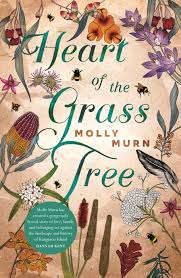Heart of the Grass Tree (Vintage Penguin Random House 2019), by Molly Murn, is a novel that combines the historical reimagining of early Australian history on Kangaroo Island in South Australia with a contemporary family saga. Written in beautiful prose that celebrates the natural environment and evokes feelings of love and loss, the book is structured in a clever and easy-to-read way that carries the reader along with the narrative and punctuates the beauty with authentic and visceral accounts of the violence of that earlier period.
The modern story centres on the death of Nell, and the uniting of her family in various states of grief in Nell’s home on Kangaroo Island. Her granddaughter Pearl was especially close to Nell, and they share more of a mother/daughter bond than Nell’s daughter Diana, or even her sister Lucy. Nell has left behind paintings, stories, poems and collections of objects, all of which lead to connections with the island’s early history: the Ngarrindjeri people and their first contact with European sealers. And this historical setting is the twin narrative running through the book – the story of William and Maringari. Nell has left behind secrets that have their genesis in that colonisation period, and her life is intrinsically connected with the people that have gone before her.
This is an engaging story about mothers and daughters, relationships and the complications of family. It is a tale about Australia’s dark history, and the sections about violence enacted on Aboriginal people are particularly shocking, authentic and raw. This is balanced by the lovely nature writing which celebrates the local flora and fauna. The author has clearly undertaken much research into the history of both Aboriginal culture and the impact of early white settlers, particularly the sealers who made their fortune on the island. And there is some nuanced symmetry between those early relationships, and romances, and Nell’s reminiscences of her own doomed love affair.
Sections of this book are written from the point of view of Indigenous characters, both a female and a male, and I found this didn’t quite sit well with me. While I can’t vouch for the author’s research, it certainly reads as if she has done the necessary work and obtained all the right permissions, and yet the question of appropriation of course rears its head. Fiction writers necessarily write from the perspectives of others different to themselves, but I wonder if it is too soon in our own country’s troubled past for this to be comfortable; white people have been here for a speck in time compared to Aboriginal culture and perhaps we should encourage space for the First Peoples to tell their own stories, in their own time and in their own way. But that is a hotly debated and polarising question about which various readers will no doubt have various opinions. And putting that aside, this is nevertheless a beautifully written tale, a love story on many levels, and a tender meditation about family relationships. Readers who enjoyed The Lost Flowers of Alice Hart by Holly Ringland or Beneath the Mother Tree by Donna Cameron will enjoy Heart of the Grass Tree.

